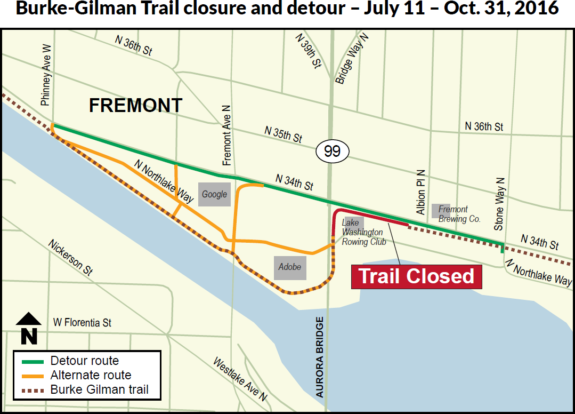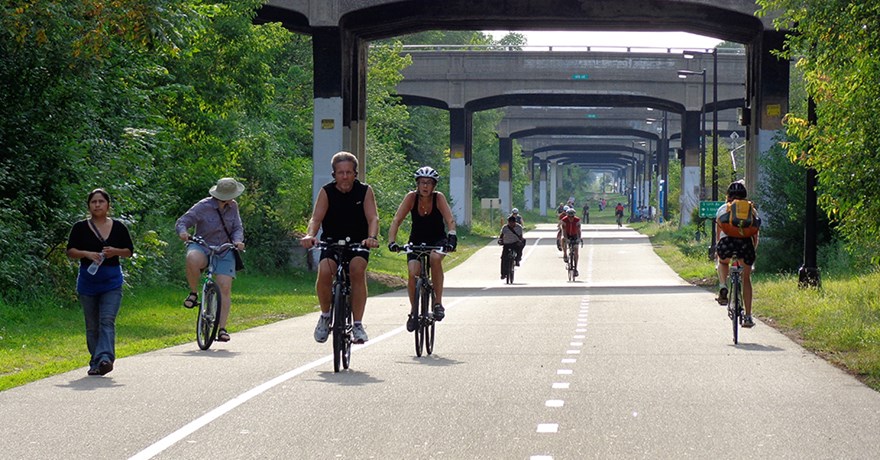
Washington Department of Transportation (WSDOT) announced last week that the Burke-Gilman Trail would be closed in Fremont until November, but recanted this week after a bit of backlash. The reason for the closure was that WSDOT wanted a storage space to stage cleaning and painting equipment for the George Washington Bridge carrying SR-99 overhead. WSDOT is trying to devise a better detour than using busy N 34th St. Doug with Wallyhood blog (different Doug than this Doug author) suggested a closure and bike detour might not be necessary at all if WSDOT uses the area west of the Lake Washington Rowing Club to stage the equipment instead. Email WSDOT to comment on the potential detour plans.

Hopefully a better plan than the original plan can be settled upon. Capriciously closing an important section of the city’s premier bike trail would have added insult to injury for an already beleaguered trail and a bad year for bicycling advocates in Seattle. Let’s review:
- The Missing Link is still missing. Close the gap. Hand it to certain Ballard business owners (i.e., Salmon Bay Sand and Gravel) for their litigious fortitude in tying up the Ballard Burke-Gilman Trail extension in a bureaucratic maze. However, the just released Draft Environmental Impact Statement (DEIS) should allow the Seattle Department of Transportation (SDOT) to finally move ahead. It’s time for Mayor Ed Murray to give the green light and jolt this stalled project to life. Too many lives are at stake to tolerate such an unsafe design on a busy trail.

The South Shilshole alternative is the clear winner in the Missing Link alternative analysis. (SDOT) - Intersection treatments are woefully inadequate. Build protected intersections. The Stone Way intersection is a good example of this and as with the Missing Link it seems nearby business are blocking improvements as Lee Raaen of the Wallingford Community Council reported a $250,000 grant won in 2015 to improve the intersection was pulled at the last minute apparently due to objections from nearby property owners. Why would businesses oppose safer infrastructure to draw in more customers by foot or bike? We need to get this project going on and improve the intersections at many points along the trail. Clearly marked and painted intersections are a bare minimum. Protected intersections earn their name with speed tables, separate bike signals, and other more aggressive interventions.
- Construction causes frequent detours. Detours must be easily navigable, have good wayfinding and be as brief as possible. Near the University of Washington the trail hasn’t been complete in years due to construction. We encourage trail-oriented development but do the closures need to last so long and come with poorly marked detours? Detours must be reasonable enough to not discourage trail users to give up entirely and clearly signed so they don’t get lost.
- The trail surface is rutted and deteriorating. Let’s resurface the worst sections. The Burke-Gilman is not a smooth ride is many sections and could sorely use a resurfacing. The stretch along the east side of UW is particularly bumpy. Why would we tolerate washboard sections on our city’s best bicycle trail?
- The trail is overgrown with vegetation. We need regular maintenance. We want the trail to be a lush green space but we don’t want trees to be clipping bicyclists or causing them to swerve dangerously. It doesn’t appear anybody is responsible for trimming back the trees and bushes that encourage on the trail which limits space which already tightly shared between cyclists, skateboarders, rollerbladers, runners, and pedestrians. The stretch northeast of Gas Works Park is the worst offender. If SDOT can’t handle the responsibility, we should put maintenance clearly on the shoulders of another entity such as a trail association.
The Burke-Gilman is a lovely trail and a regional asset. However, it doesn’t get the tender love and care it deserves. The finer details matter. We should not announce last minute closures of the trail without thinking through high quality detours. Delaying the closure gets WSDOT some points but doesn’t erase that our departments of transportation were ready to shut down a key part of the trail for four months during peak riding season without providing a quality detour. Many cities have whole networks of off-street trails. Before I moved to Seattle, I lived in Minneapolis where the Midtown Greenway—more than a mere multi-use trail—functions like a freeway for bikes, allowing bicyclists to race through a congested portion of Minneapolis in comfort nearly completely separated from auto traffic. We have some work to do to get the Burke-Gilman operating that smoothly.

We should not allow the Burke-Gilman Trail status as Seattle’s best trail allow us to get complacent and prevent us from turning this precious right-of-way into a world class bicycle facility. Right now progress on Burke-Gilman Trail and bike infrastructure throughout the city seems frozen and bicycling advocates are struggling to get momentum. I trust this isn’t a Sisyphean task, but it certainly feels like we’ve seen the boulder roll back down the hill quite a few times.
Doug Trumm is publisher of The Urbanist. An Urbanist writer since 2015, he dreams of pedestrianizing streets, blanketing the city in bus lanes, and unleashing a mass timber building spree to end the affordable housing shortage and avert our coming climate catastrophe. He graduated from the Evans School of Public Policy and Governance at the University of Washington in 2019. He lives in East Fremont and loves to explore the city on his bike.




